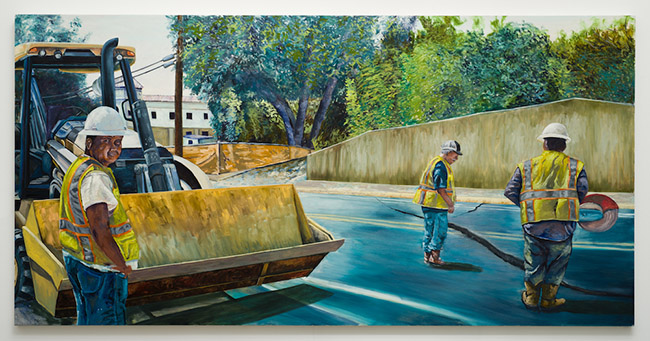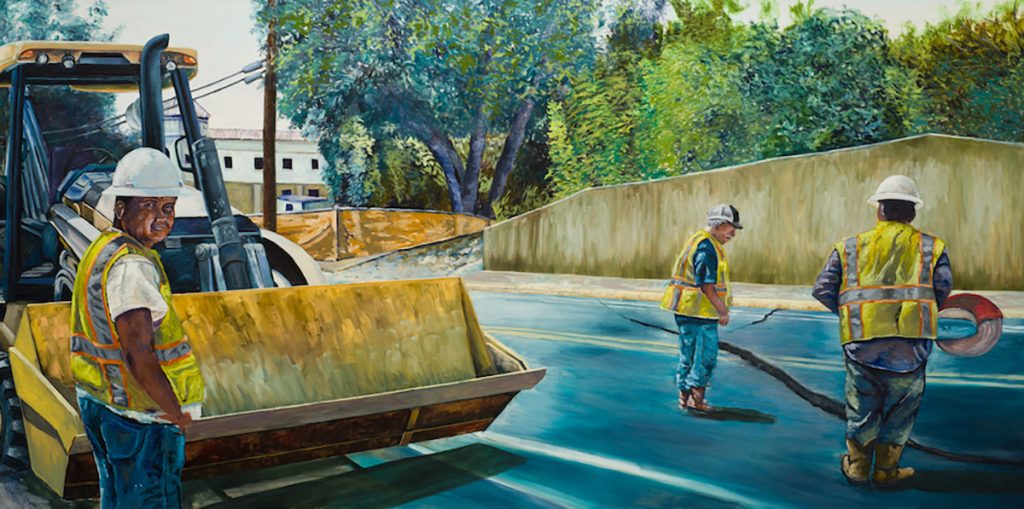Augustine Chavez, based in San Marcos, Texas, is an artist whose work springs from deep personal experiences and the political climate surrounding immigration in the United States. His art captures the struggles and resilience of the undocumented workforce, a community often overlooked and mischaracterized. Chavez’s creative journey is driven by his commitment to amplifying the voices of laborers and immigrants through a variety of mediums, including painting, sculpture, photography, concrete, and found objects. For Chavez, art is not only an outlet for self-expression but also a powerful tool for social commentary. His process is rooted in real-life observation, with Chavez often photographing laborers at construction sites to authentically represent their contributions to society. Whether through depictions of his indigenous heritage or explorations of working-class life, Chavez’s work carries a potent blend of personal reflection and broader social critique.

Here is the artist’s interview.
What is your creative process like?
My process beings the minute my alarm goes off. I use to wait to be inspired to make art, but thats all amateur. One quote that really made things clear for me was when Chuck Close said, “Inspiration is for Amateurs, the rest of us get to Work.” I do not have a choice but to make art. I am an artist. My concentration is of the working class, so I drive out in the mornings and look for constructions sites to spy on. I have a DSLR camera with a zoom lens and I park somewhere not too close. I take photographs of people working, but most of the time, my son is taking photographs for me while we are driving. He gets a little annoyed but he will still do it. I then go back to my studio and comb thru the photos. Then I start to make selections of which ones I can use to create a type of art work. Some ideas a better off as a sculpture and some are better off as paintings. Lately I have had a lot of studio ghost which interfere with new ideas I may have, but I am trying to make them go away. I make preparations to make my art during the day and then paint at night. I have always complained about the many interruptions I have during the day that make me work at night, but I realized that even if I do not have any interruptions, I still find myself painting at night. I have started a new concept that involves molding clay, so I will start a painting and get to a stopping point, while that layer is drying in my painting, I will get to work on the
molding clay and make a figure. Then I will return to my painting, or photography, or sculpture. I try to allow myself to work on what is in my mind at that moment. Then I try to get some sleep and then start all over again.
Do any personal experiences shape your work?
I would have to say that my family is the main driver in all my work. I do not come from a close relationship family and all my family are laborers. My father and my mother picked cotton when they were kids and that just blows my mind. We struggled a lot and I thought that was a normal way to live, but as an adult and as an artist, I see now that the struggle is due to capitalist systems that only benefit certain social classes which we are not apart of. I suppose that is why I am attracted to making art about the working class because I feel we make large contributions to the United States and we are overlooked. But at a more personal level, I also love to make art about my indigenous heritage. My grandmother would perform healing to us, but I was too young to appropriate her prayers. Now, as an adult, I walk the Red Road and try to make personal works about those ways of life. My
son is also a big contribution to my art. I aways tell people that out of all my art, my son is my masterpiece. I had always wanted to be an artist, but in my family, we were told to get a job. So I worked as a housekeeper when I graduated from High School. Since then I have had many jobs, but when my son was born, I felt the need to quit all that I was doing and pursue art. I have been a single father since my son was two and he has been with me this entire time.
What challenges do you face as an artist?
The biggest challenge is finances. I mean, it is hard and with this economy, no one wants to by art. I know there are art grants out there, but the reality is that so many artists apply and a few are selected. I do not like to live my life based on hope, Id rather live it by solving my own problems and whatever I earn goes back into buying supplies. There is a saying that those who struggle are the only ones who can make meaningful art. I am not sure that I agree with that, but I can defiantly understand it. I have so many ideas and I am also working on a new concept that is totally different from anything I have done, which will involve photography, but it all comes down to being funded. Something I have noticed is that I have to make a landscape every now and then and sell it. People like landscapes.
What do you want people to feel when they see your art?
What I try to strive for, from the viewer is acceptance. I have had experiences where politicians
demanded my art be removed from an exhibition because it was tasteless art. But people fought to keep them up and they stayed up. I have also had experiences where I saw people hitting my paintings, like lightly punching them. It felt like if they wanted to punch me for making that type of art. I am a brown indigenous man, and the majority of the time, I feel like I do not belong in an exhibition. But I want my art to reflect many things, not just the message in the art, but to reflect me, as an artist and to reflect my skill. I also want it to reflect my people as a whole. I want the viewer to feel what its like to be in my brown world. There is still a lot of work to be done, and I will continue to make art, even if I have earn my way to be accepted.
Augustine Chavez’s art offers a vivid portrayal of the lives and experiences of those often left unseen. By combining his personal history, cultural identity, and social consciousness, he creates work that challenges established narratives and invites empathy. Chavez remains steadfast in his creative journey, navigating financial obstacles and social rejection with resilience. His dedication to art as a means of advocacy and personal storytelling continues to shape a powerful body of work that speaks to both his own experiences and the broader struggle for recognition and acceptance.


